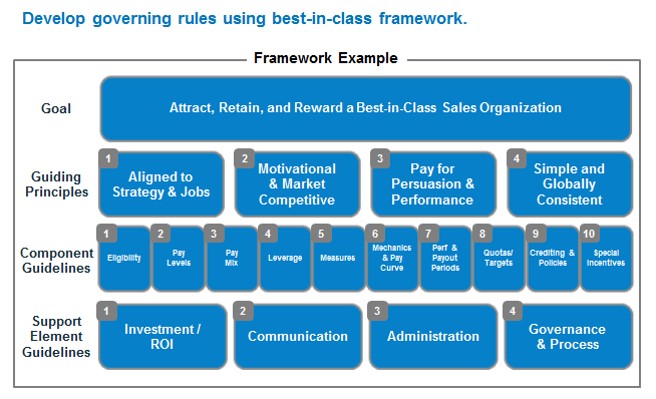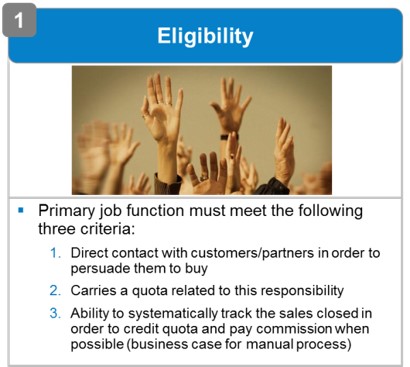Use a Principle-Driven Approach in Sales Comp Planning

<It’s sales compensation season again, and companies are preparing for their annual process of designing sales compensation plans for the sales force. Those in charge of driving the process often “gear up” knowing in advance how lengthy the discussions can be, driven by a host of opinions, politics and personalities. Sales compensation professionals have a right to worry. Often sales leaders and key stakeholders come to the table with their own opinions of what’s right and wrong based on past experience, but not grounded in industry best practices. Additionally, multiple opinions lead to circular discussions, time delays and indecisions. In worst case, sales compensation professionals, often at the mercy of getting plans out on time, make compromises in designing plans that meet best practices.
To address this situation, AGI recommends a process that defines a unified and agreed to set of principles and guidelines that are used to govern sales compensation design and execution. At AGI, we call this a “Principle Driven Sales Compensation Framework” (see example below). The framework includes a Goal, Guiding Principles, Component Guidelines, and Support Element Guidelines. The framework does not specify a specific in-year plan design; rather, it provides market-competitive and philosophy-aligned design guidelines within which all plans must live. The key to a successful framework is that it stays stable over time. As such it reflects a true long-term company philosophy and is not influence by fiscal year goals and objectives.
Before building out the principle framework, companies must spend time with the C-suite to confirm its total reward philosophies with regard to key areas such as:
a) The role of sales compensation as a lever for performance management
b) Total pay relative to competitors for talent and level of differentiation in pay between high and low performers
c) Expected level of quota participation (i.e., the percent of the population achieving quota)
d) Levels of consistency vs. variance across various regions or business units
Once the philosophies are defined, companies can then work with their C-suite to develop a set of guiding principles that reflect their previously agreed to philosophies (see second row in framework example above). Principles are a set of guiding rules or laws that govern the overall program design. Principles are sacrosanct: no deviations from principles allowed!
The next level of the framework articulates the company’s guidance for all the components of a plan design – from guidelines on what makes a role eligible for a sales plan through proper use of add-on bonuses such as SPIFs or contests (see all 10 component areas detailed in framework above). A task force should convene to spell out these guidelines and ensure that they re-enforce the guiding principles. See detailed Eligibility guidance below. While the principles are sacrosanct, a design team may break a component guideline for a particular role/plan; however, they must obtain approval through the governance. To really drive home the component guidelines, AGI recommends that companies apply the component guidelines to each platform job in the form of a goalpost!
Lastly, the framework also includes a section of support element guidelines that provide standards for how the company will manage the sales compensation program. Herein, the framework lays out guidance on how the company will cost, communicate, administer and govern the program.
While it takes effort to build out and obtain executive buy off, the framework will offer tremendous value to the company. Most importantly, a principle driven approach virtually assures that industry best practices will be incorporated into the design sales compensation plans. Secondly, having a framework to fall back on will alleviate the rat holes that plan design committees often run into with the many plan design requests that are often pushed forward. This in turn gives back time that can be better used to discuss sales strategy and how the sales compensation plan can support that effort.
Sales compensation leaders may also leverage the principle framework to educate leadership and other key stakeholders involved in the design process. A by-product of providing education is that the sales compensation leader elevates the perception of his or her role as a strategic advisor as opposed to a tactical facilitator. This is especially true when they are able to provide both principles framework and the reasoning behind each guideline.
Summing it all up, a “Principle Driven Sales Compensation Framework” delivers lots of value to the sales compensation leader. Instead of “gearing up,” sales compensation professionals can focus on delivering strategic value and staying ahead of the game.
Learn more about our sales compensation program management practice.

